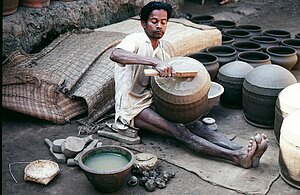Temple Potters of Puri
An archive by Louise Allison Cort and Purna Chandra Mishra
The Kumbhara Bishoi are a distinctive community of potters who, as hereditary temple servants (sevaka) of the Jagannath Temple in the city of Puri, Odisha (formerly Orissa), supply a repertory of earthenware cooking and serving pots to the temple kitchen. As a pilgrimage center of national importance, the Jagannath Temple requires new earthenware vessels in great quantities for the daily production, offering, and distribution of the sacred food (mahaprasad) that is an indispensable feature of ritual and pilgrimage. Centering on rice and including traditional vegetarian dishes, the sacred food is offered to the deities of the temple five times each day before being distributed to temple servants and pilgrims. Auspicious red color and faceted surfaces distinguish the earthenware vessels admitted to the temple kitchen for the purpose of preparing this food from the plain black cooking pots made for the ordinary market. Each vessel is used just once in the kitchen, in order to preserve the ritual purity imbued by the flames of the potter’s kiln. The role of the Kumbhara Bishoi potters is to replicate perfectly the prescribed vessel color, forms, and sizes and send a steady stream of identical new vessels to the temple. Male potters, carefully trained in the repertory and formally inducted as temple servants by receiving a cloth once draped on the sacred images, provide the cooking vessels; their wives prepare smaller, hand-formed serving bowls and lamps. The potters live in three villages on the outskirts of Puri—Kumbharapada, Tikarapada, and Gopalpur.
Records of the Kumbhara Bishoi reach deep into the past and mytho-history. The Kumbhara Bishoi proudly trace their origins in a text, the Kurala Purana, which relates how Vishnu created the first potter to provide pots for preparing the cooked food that would distinguish humans from animals. The text is read aloud each year as part of the potters’ annual observation of Kurala Panchami, a multi-day interval when the potters clean, decorate, and worship the tools of their craft—the workshop, the kiln, the wheel, and the paddle and anvil and other implements. The potters also revere the legend of their ancestor, the potter’s wife Neli Kumbharuni, whose devotion to her service of delivering pots to the temple earned the right to occupy the land where the potters now live and work. Records of the induction of successive new generations of male potters as temple servants appear in the temple’s administrative records, the Madala Panji. Documents of struggles over the potters’ landholding survive in British colonial archives. Simultaneously, however, the potters experience tensions arising from the brutality of caste-based hierarchy and cash-based exchange penetrating the modern temple’s daily operations.



